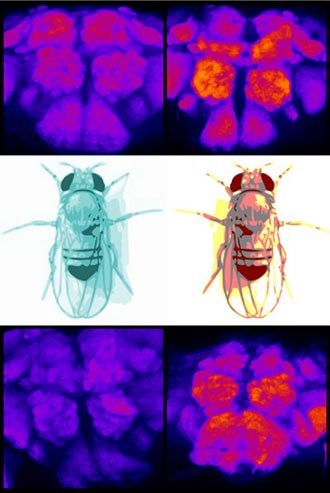Sleep: Spring cleaning for the brain?
If you’ve ever been sleep-deprived, you know the feeling that your brain is full of wool.

On the left, the brain of the well-rested blue fly has low levels of a synaptic protein called BRP in this 3D view from a confocal mircoscope. On the right, the brain of the sleep-deprived fly glows orange in areas of BRP concentration. (Bruchpilot or BRP is a protein involved in communication between neurons.) In the tired fly, the protein is present at high concentartions in three major areas of the fly’s brain that are associated with learning. Sleep reduces the levels of this protein, an indication that synapses get smaller and/or weaker. This process of “downscaling” may be important so the brain is reset to normal levels of synaptic activity and can begin learning again the next day.
Photo: courtesy UW Health Public Affairs
Now, a study published in the April 3 edition of the journal Science has molecular and structural evidence of that woolly feeling — proteins that build up in the brains of sleep-deprived fruit flies and drop to lower levels in the brains of the well-rested. The proteins are located in the synapses, those specialized parts of neurons that allow brain cells to communicate with other neurons.
Sleep researchers at the University of Wisconsin–Madison School of Medicine and Public Health believe it is more evidence for their theory of “synaptic homeostasis.” This is the idea that synapses grow stronger when we’re awake as we learn and adapt to an ever-changing the environment, that sleep refreshes the brain by bringing synapses back to a lower level of strength. This is important because larger synapses consume a lot of energy, occupy more space and require more supplies, including the proteins examined in this study.
Sleep — by allowing synaptic downscaling — saves energy, space and material, and clears away unnecessary “noise” from the previous day, the researchers believe. The fresh brain is then ready to learn again in the morning.
The researchers — Giorgio Gilestro, Giulio Tononi and Chiara Cirelli, of the Center for Sleep and Consciousness — found that levels of proteins that carry messages in the synapses (or junctions) between neurons drop by 30 to 40 percent during sleep.
In the Science paper, three-dimensional photos using confocal microscopy show the brains of sleep-deprived flies filled with a synaptic protein called Bruchpilot (BRP), a component of the machinery that allows communication among neurons. In well-rested flies, levels of BRP and four other synaptic proteins drop back to low levels, providing evidence that sleep resets the brain to allow more growth and learning the next day.
“We know that sleep is necessary for our brain to function properly, to learn new things every day, and also, in some cases, to consolidate the memory of what we learned during the day,” says Cirelli, associate professor of psychiatry. “During sleep, we think that most, if not all, synapses are downscaled: at the end of sleep, the strongest synapses shrink, while the weakest synapses may even disappear.”
The confocal microscope views show this happening in all three major areas of the fruit-fly brain, which are known to be very plastic (involved in learning).
In a paper published last year, Tononi, Cirelli and their co-investigators found similar chemical changes in the synapses of rats’ brains. They also showed that rats’ brains have a stronger “evoked response” to electrical stimulation after being awake, and a weaker one after sleep. That finding provided more evidence, using electrophysiological rather than molecular techniques, consistent with the idea that synapses grow stronger during the day, then weaker during sleep.
Because sleep performs the same function in the brains of species as diverse as fruit flies and rats, Cirelli says it was likely conserved by evolution because it is so important to an animal’s health and survival.
The Wisconsin laboratory has pioneered ways of studying sleep in different species, including fruit flies.
To keep the flies awake, they’re put into a “fly agitator” that holds 10 plates, each containing 32 drowsy flies. A robot arm shakes the plates occasionally to keep the flies from dozing.
Flies were deprived of sleep for as long as 24 hours. Researchers then dissected their brains and measured the levels of four pre-synaptic proteins and one post-synaptic protein. All levels rose progressively during periods of wakefulness and fell after sleep. Other experiments confirmed that the changes in protein levels were not caused by exposure to light and darkness or by the stimulation itself, but by sleep and waking. They also used confocal microscopy and an antibody that specifically recognizes BRP to measure the expression of this protein in many fly-brain areas.
Higher levels of these synaptic proteins during waking may be evidence of random experiences that fill the brain every day and need to be dissipated to make room for the learning and memories that are truly significant.
“Much of what we learn in a day, we don’t really need to remember,” Cirelli says. “If you’ve used up all the space, you can’t learn more before you clean out the junk that is filling up your brain.”



